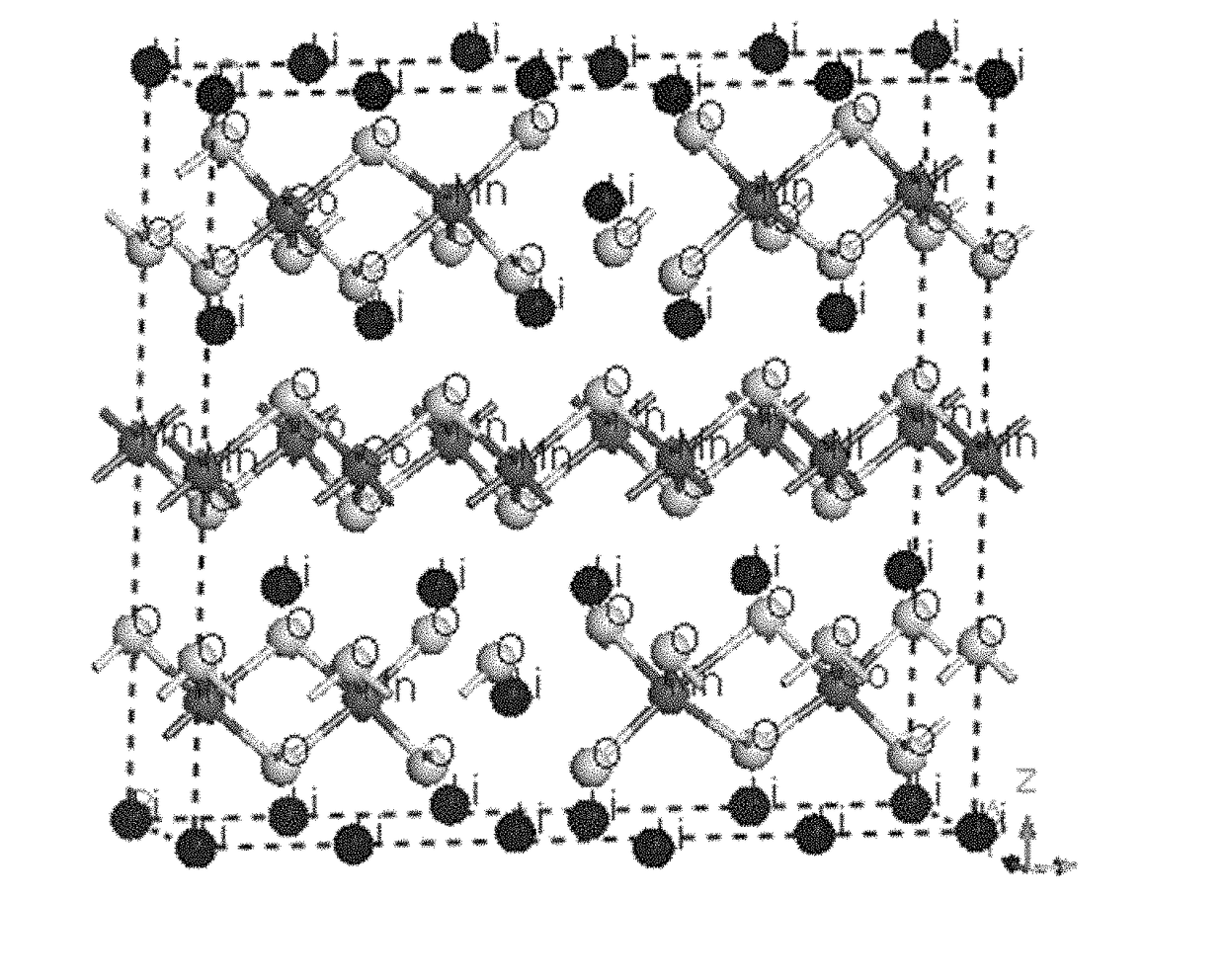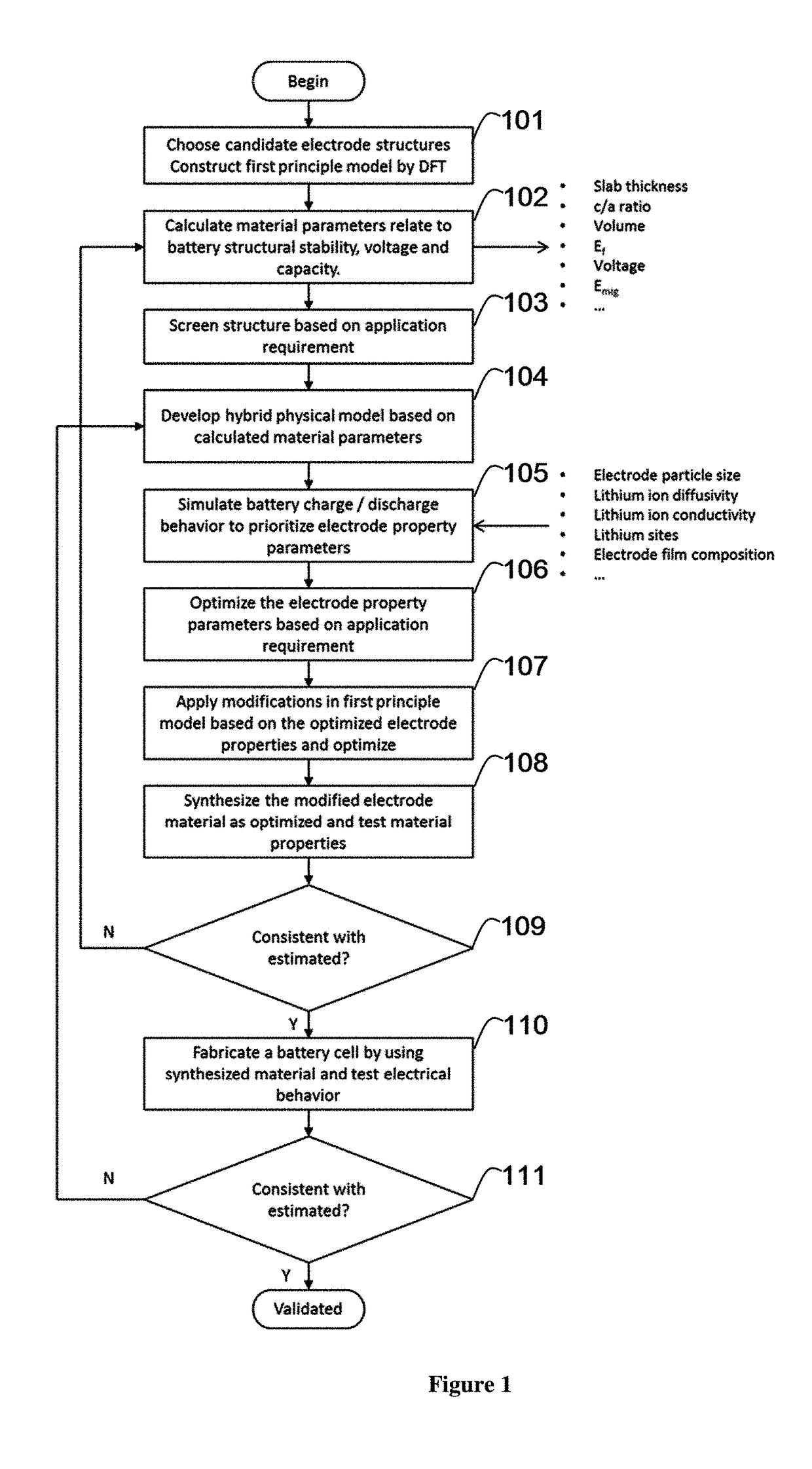Method of designing and modifying lithium ion battery cathode materials
a lithium ion battery and cathode material technology, applied in the direction of cell components, sustainable manufacturing/processing, instruments, etc., can solve the problems of low charge capacity, limited application to experimental research, and limited further enhancement of lib performance, so as to achieve higher calculation speed and high precision
- Summary
- Abstract
- Description
- Claims
- Application Information
AI Technical Summary
Benefits of technology
Problems solved by technology
Method used
Image
Examples
example 1
Simulation of Undoped and Mg Doped Li-Rich Layered Oxide (LLO)
[0118]First principle simulation based on Density Functional Theory (DFT) was conducted by using Material studio CASTEP. Trigonal system with space group of R-3M was constructed. Fractional coordinate for different elements are: Li (0,0,0), O (0,0,0.2594), transition metal (0,0,0.5). Transition metal elements include Ni, Co and Mn. Initial lattice constants were set as a=0.2823 nm and c=1.3890 nm. Then a super lattice was constructed by combining 5×1×1 unit cell. For the calculated Li-rich layered oxide, 2 Li atoms occupied transition metal position. In the super cell, there were totally 17 Li atoms, 3 Co atoms, 3 Ni atoms, 8 Mn atoms and 30 O atoms for the undoped LLO (FIG. 2). For the Mg doped LLO, one Li atom in the Li layer was replaced by Mg atom (FIG. 3).
[0119]Geometry optimization was conducted first with the function of General Gradient Approximation (GGA), cutoff energy of 950 eV, ultrasoft pseudopotential and sp...
example 2
Simulation of Fe Doped Li-Rich Layered Oxide
[0128]The procedure of Example 1 was repeated, except that 1 Co atom was replaced by Fe atom (FIG. 6). The simulation results are shown in Table 3. Fe doped LLO shows larger slab thickness after delithiation (x=0) which is favorable for Li intercalation, and higher c / a ratio indicating a better layered structure. These could contribute to higher charge-discharge efficiency. Fe doped LLO also has smaller volume (x=1) due to the shorter and stronger bond between transition metal and oxygen which can reduce oxygen loss and structure changes, and lower formation energy as compared to undoped LLO indicating more stable structure. These could contribute to better cycle performance. Finally, Fe doped LLO shows much higher voltage and lower migration energy (i.e. higher diffusivity). These could contribute to higher capacity.
TABLE 3the simulation results for undoped and Fe-doped LLO in Example 2Li contentUndoped LLOFe doped LLOSlab thickness (Å)x ...
example 3
[0133]Simulation of Undoped and Al Doped LiMn2O4
[0134]Cubic system with space group of FD-3M was constructed. Fractional coordinate for different elements are: Li (0.125,0.125,0.125), O (0.261,0.261,0.261), Mn (0.5,0.5,0.5). Initial lattice constants were set as a=0.8245 nm. In the unit cell, there were totally 8 Li atoms, 16 Mn atoms and 32 O atoms for the undoped LiMn2O4 (FIG. 8A). For the Al doping, one Mn atom was replaced by Al atom and another Mn atom was replaced by Li atom (FIG. 8B). The following simulation procedure was the same as in Example 1, except that cutoff energy of 900 eV was used.
[0135]The simulation results are shown in Table 5. Al doped LiMn2O4 shows smaller structure changes during delithiation and lower formation energy as compared to undoped LiMn2O4 indicating more stable structure. These could contribute to better cycle performance. Besides, Al doped LiMn2O4 shows much higher voltage. These could contribute to higher capacity.
TABLE 5the simulation results ...
PUM
| Property | Measurement | Unit |
|---|---|---|
| first principle density function theory | aaaaa | aaaaa |
| DFT | aaaaa | aaaaa |
| lattice structure | aaaaa | aaaaa |
Abstract
Description
Claims
Application Information
 Login to View More
Login to View More - R&D
- Intellectual Property
- Life Sciences
- Materials
- Tech Scout
- Unparalleled Data Quality
- Higher Quality Content
- 60% Fewer Hallucinations
Browse by: Latest US Patents, China's latest patents, Technical Efficacy Thesaurus, Application Domain, Technology Topic, Popular Technical Reports.
© 2025 PatSnap. All rights reserved.Legal|Privacy policy|Modern Slavery Act Transparency Statement|Sitemap|About US| Contact US: help@patsnap.com



